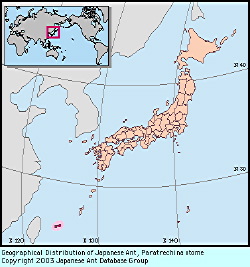
|
species
|
Paratrechina otome
|
 |
Japanese Name
|
Hiyowa-ameiro-ari
|
Original Reference
|
|
Terayama, M. (1999) Taxonomic studies of the Japanese Formicidae, part 5. Genus Paratrechina Motschoulsky. Memoirs of the Myrmecological Society of Japan 1: 49-64.
|
Description
|
|
Total length of workers around 1.5-2 mm. Head and lateral surfaces of mesosoma pale brown; antennae, dorsum of mesosoma, petiole and legs brownish white; gaster brown.
Mandibles with 6 teeth. Antennal scapes exceeding posterior margin of head by half their length; without erect hairs. Eyes small; maximum eye length less than the 1/4 head length. Ocelli distinct. Mesosoma relatively long. Metanotal groove incised. Erect hairs on head and gaster shorter and more spaced than in P. longicornis. Mesonotal dorsum with a pair of erect hairs. Propodeum, hind femora and tibiae without erect hairs. Body cuticle thin, easily collapsed.
|
Remarks
|
|
This species resembles P. longicornis and P. yambaru. It is easily distinguished from P. longicornis by its shorter antennal scapes and the 3 pairs of setae on its mesosomal dorsum, and from P. yambaru by its distinctive coloration. P. otome is found in grasslands and at forest margins.
|
|

Distribution
|
|
Nansei Is (Ishigaki I., Iriomote I.).
|
|
References
|
|
- Terayama, M. (1999). Taxonomic studies of the Japanese Formicidae, part 5. Genus Paratrechina Motschoulsky. Memoirs of the Myrmecological Society of Japan 1: 49-64.
|
Editor
|
|
Original text by Keiichi Onoyama, Masaaki Morisita & Mamoru Terayama. English translation by Mamoru Terayama, edited by Robert W. Taylor.
|
|